Here is my translation of GM Sergey Shipov’s analysis of the seventh game of the World Championship match. I was going to call this post “OLd Man Chess” because Shipov criticizes Anand at one point for playing like an old man. But I decided that title would not give justice to the beautiful mating net woven at the end by Gelfand with his rook and knights. The knights were definitely dancing in Moscow tonight! — DM
Greetings, my esteemed lovers and connoisseurs of chess. Grandmaster Sergey Shipov invites you to the World Championship match, taking place in Moscow. The second half of the competition is beginning. We have already played the first period, and we have learned one thing for certain — the contestants are beautifully prepared in the opening, they are defending beautifully, but they have not had enough energy to attack. By the way, speaking of halves… Yesterday’s final of the Champions League [For anybody reading this years later: Sergey is referring to the soccer championship on the previous day, in which Chelsea defeated Bayern Munich on penalty kicks. — DM] could very well serve as a prototype for our chess match. In order for that to occur, Anand and Gelfand would need to trade victories in regulation time and then play a tiebreak. For a perfect analogy, the champion should be the one who stands lower in the rating list and who previously was not champion … as revenge for the defeat of Barcelona! [Gelfand is a fan of Barcelona, which was eliminated by Chelsea. — DM] I don’t think Boris will object to this scenario.
But for now, he has to demonstrate something new in the opening. Vishy stubbornly chooses the same variation of the Slav Defense and for now he has comfortably equalized. In this connection, I strongly doubt that Gelfand’s seconds calmly lay around and watched the soccer game on television yesterday. They were probably smoking like devils! A great deal depends on them, the faithful assistants of the players. Whatever they find may be used in the next game. We’ll see what Khuzman, Rodshtein, Elyanov and one other whom I don’t know have come up with.
(1) Gelfand,Boris – Anand,Viswanathan [D45]
World Championship Match (Game 7), 20.05.2012
[Shipov, Sergey (translated by Dana Mackenzie)]
1.d4 d5 2.c4 c6 3.Nc3 Nf6 4.e3 e6 5.Nf3 a6
We go down the path we have already traveled.
6.c5
Let’s study a new variation! White closes the game in hopes of obtaining a large space advantage.
6…Nbd7
The answer was played very rapidly. The champion’s camp foresaw this turn in the conversation. [6…b6 is another topical mover here. Here is how the world champions of the past continued: 7.cxb6 (7.b4 is obviously bad because of 7…a5 destroying White’s pawn structure) 7…Nbd7 8.Na4 (8.Bd3 is more popular in our time, for example, 8…c5 9.0–0 Bb7 10.Na4 c4 11.Bc2 Nxb6 12.Bd2 Nbd7 13.b3 cxb3 14.axb3 a5 15.Ne5 Bd6 16.f4 with an intense battle, F. Caruana – S. Rublevsky, Dagomys 2010.) 8…Nxb6 9.Bd2 Nxa4 10.Qxa4 Qb6 (Later it turned out that Black can equalize with 10…Bd7 11.Ne5 c5!) 11.Rc1 Bd7 12.Ne5 Qxb2 13.Nxd7 Nxd7 14.Bd3! Rb8 15.Ke2 White obtained a lasting initiative and won a brilliant game, M. Euwe – A. Alekhine, Netherlands 1935.]
7.Qc2
A very clever introduction. Can it be that White has no more useful, more developing moves? [7.b4 is more like what I expected. Again there are examples of this theme in the classical canon: 7…a5 (In our days Black reacts more in the spirit of the popular schemes in the Queen’s Gambit: 7…b6 8.Bb2 Be7 9.Bd3 0–0 10.0–0 a5 11.a3 Ba6 12.Qe2 Bxd3 13.Qxd3 Qc7 14.h3 Rfb8 etc., M. Matlakov – D. Jakovenko, Dogomys 2010.) 8.b5 Ne4 9.Nxe4 dxe4 10.Nd2 f5 11.f3 Qh4+ 12.g3 Qh6 13.Qe2 Be7 14.Bg2 0–0 15.0–0 Nf6 16.Nc4 Bd8 17.fxe4 fxe4 18.Nd6 Qg6 19.b6 Be7 20.Nc4 Qg5 21.Bd2 e5 22.Nxe5 Be6 23.Rf4 and Black did not have enough compensation for the pawn, M. Euwe – A. Alekhine.]
7…b6
A reasonable objection. One must distract the pawn on c5 while it is still not in a position to be supported by its buddy on b4. [The devotees of this variation for Black would look first of all at the brilliant break 7…e5 and they would receive encouragement from the far from perfect game T. Radjabov – A. Grischuk, Bastia 2003: 8.dxe5 (However, Black will not be so happy after he realizes that White does not have to enter into complications: 8.b4!? e4 9.Nd2 with the idea of a breakthrough on the queenside. Further, in the game A. Kveinis – P. Velikov, Cappelle-la-Grande 2005, the breakthrough took place in a part of the board where it was not expected. 9…g6 10.Be2 h5?! 11.f3! exf3 12.Nxf3 Bh6 13.e4! Bxc1 14.Rxc1 dxe4 15.Nxe4 0–0 16.Nd6 Nd5 17.Qd2 Qe7 18.0–0 and things have turned out sadly for Black) 8…Ng4 9.e6 fxe6 10.Bd3 Ngf6 11.Ng5 Nxc5 12.Bxh7 Nxh7 13.Qg6+ Kd7 14.Nf7 Qh4 15.g3 Qh3 16.Nxh8 Kc7 17.Nf7 Bd7 18.Ne5 Be8 19.Qc2 Bd6 with an initiative for Black. Here I have deliberately not added any punctuation marks or recommendations, because this was after all a blitz game — just for fun!]
8.cxb6
There is no other way… [No, there is another way! In fact White could play the move 8.b4 a5 9.b5! with the idea of breaking through with the pawn on c6. However, Black can play the ultra-calm move 9…Bb7 , move the rook from a8 and force favorable exchanges.]
8…Nxb6
A novelty! Here Black has usually played [8…Qxb6 . For example, 9.Na4 Qc7 10.Bd2 Be7 11.Rc1 Bb7 12.Bd3 a5 13.0–0 0–0 14.Rfd1 Rfc8 15.a3 Ba6 and Black is close to equality. S. Loiret – M. Grabarczyk, Cappelle-la-Grande 1994.]
9.Bd2
Boris hints at pressure along the c-file. The knight on c3 will soon head for a4. The only remaining question is what White has prepared to do about 9. … c5.
9…c5
Vishy is also interested in the same question. Why bother defending a weak pawn if you can just get rid of it? [The process of banal development with 9…Bd6 10.Bd3 0–0 would have been interrupted by the weighty blow 11.e4! giving White a large advantage in all variations.]
10.Rc1
There can be no two opinions about it — Gelfand is following his home preparation. Otherwise he would not have hurried so much… Anand has now buried himself in calculations for a while. Apparently he was somewhat mistaken in his expectations. [There was no tactical refutation of Black’s idea: 10.dxc5 Bxc5 11.Nb5 (11.Nxd5? Qxd5) 11…Ne4! 12.Bd3? axb5 13.Bxe4 dxe4 14.Qxc5 exf3 and Black eats more material than White.]
10…cxd4
Simplest and solidest. [After 10…c4 Black would have to reckon with 11.b3 and the ensuing variations are extremely difficult to decipher over the board — 11…Bd7 (11…Bb7 12.Rb1!) 12.bxc4 (12.Ne5 Rc8 13.a4!?) 12…Nxc4 13.Bxc4 dxc4 14.Rb1 Qc7 15.0–0 with e3-e4 to follow.]
11.exd4
White battles for the center without concern for the break in his pawn structure. The upcoming activity of his pieces, along with the unfavorable position of the knight on b6 and the bishop on c8, give him hope for a sustained initiative.
11…Bd6
On the other hand, Black for the time being has no obvious weaknesses. After castling he will put the bishop on b7, the rook on c8, and… we’ll have to see what to do after that. One way or another, the good news here is that unlike the previous “White” games of Gelfand we have gotten a non-trivial pawn structure along with a full complement of pieces. This means we are in for a great battle! By the way, the challenger is thinking seriously. Apparently he has also run into something unexpected. Probably he was more anticipating the continuation … c5-c4, closing the position, instead of the trade on d4. The time remaining is equal on both sides — 1:32–1:32.
12.Bg5
Justifying the waste of time. Boris is trying to make use of the absence of Black’s bishop from e7. But I am not certain that the pin on the knight on f6 will bother Vishy. In the final analysis, a trade on f6 with a capture by the g7 pawn does not look promising for White. [What White could do after the more banal 12.Bd3 0–0 13.0–0 Bb7 is a question that we could spend qute a long time on. Again, the bishop sortie to g5 is possible, or the more clever move 14.Rfe1 Rc8 15.Qb3 Nf3-e5. Probably White could develop an initiative on the queenside here.; 12.Na4 could be considered here, but here Black has several defenses, such as 12…Nxa4 13.Qc6+ Bd7 14.Qxd6 Ne4 15.Qa3 Nxd2 16.Nxd2 Qe7]
12…0–0
Played without long hesitation.
13.Bd3
With the threat of taking on h7.
13…h6
The hunted moves away from the firing line and becomes the hunter.
14.Bh4
Gelfand played quickly and confidently. Apparently he has understood what he wants to play next — he has worked out a plan of action. The move … h7-h6 invites an assault on the Black king by White’s pieces. [The saucy advance 14.h4 makes no particular sense here, because Black after all is not even going to consider taking on g5. Instead he will try to open up the center. And the White king will have nowhere to hide except on the kingside, in which case the move h2-h4 will look positionally illiterate.]
14…Bb7
For the moment Black has a couple tempi to harmonize his position. Black can blcok the dangerous diagonal b1–h7 (on which, by the way, White would like to reverse the order of the pieces in the white-squared battery) with the move … Nf6-e4, or he could in the future place the b6 knight on f8, reinforcing the h7 square.
15.0–0
It’s time. After this White would like to drive in the nail on e5. It will be the base for the upcoming attack on the kingside. [I am both surprised and anmused by the passion of certain programs for doubling the opponent’s pawns. Here, for your amusement, is one of the variations they suggest: 15.Qb3 Rb8 16.Bxf6 gxf6 17.0–0 e5 18.Bf5 e4 19.Nd2 Nc8 after which even here the machine evaluates White’s chances rather optimistically. The rude awakening will happen later. Don’t believe the computer every time about everything, my friends! It is better to trust your own eyes.]
15…Qb8
A strange and, if it had been played by anyone but Anand, I would have said an artificial maneuver. Why go in for such tricks when therte are so many simple, natural moves? I understand that he is not afraid of the trade on f6. But in fact, the arrangement of Black’s heavy pieces (the queen has made itself scarce, the rook on a8 is locked up) gives White some grounds for taking on f6. Followed by the foray Nc3-e2-g3-h5. Of course, Gelfand is taking his time here. You have to deal with the initial surprise, put your emotions to the side, calmly consider the pluses and minuses, and calculate the optimal solution. [15…Nbd7 was the first move I looked at, with elementary play in the center: 16.Rfe1 Rc8 17.Ne5 Qb6 18.Qd2 Rfe8 19.Bb1 Bf8 and on the direct 20.Qd3 Black has 20…Nxe5 21.dxe5 Ne4 . Likewise on 20. Re3; 15…Bf4 is a second possibility, and Black can seize the c-file by 16.Rcd1 Rc8 17.Ne5 Qc7 , with the idea, after 18.Bg3 Bxg3 19.hxg3 (19.fxg3 Ne4) 19…Nbd7 20.Qe2 Nxe5 21.dxe5 Nd7 22.Rfe1 , of beginning counterplay in the center by 22…d4! 23.Na4 (23.Ne4? Nxe5!) 23…Rfd8 with good chances of reaching a healthy old age.]
16.Bg3
An intentionally quiet move. It would appear that Boris was a little bit too successful in the battle with his own emotions! [16.Rfe1 begged to be played, followed by Qc2-e2 and Nf3-e5.; Also, I insist, it would have been very interesting to play 16.Bxf6 gxf6 17.Ne2 , for example, 17…Rc8 18.Qd2 Bf8 19.Rxc8 Nxc8 20.Ng3 Nd6 21.Nh5 Qd8 22.Qf4 and Black will have to place his knight on e8, which is, though not fatal, at least unattractive. The alternative 22…f5 essentially loses after 23.g4! fxg4 24.Qxg4+ Kh8 25.Kh1! and after Rf1–g1 the game is over. Of course this is only an illustration of the dangers facing Black, but it was worth thinking about…]
16…Rc8
The only logical justification of the queen maneuver to b8 — the king rook immediately joins the battle. But it achieves this joy at the cost of the queen rook’s tears… Visually and intuitively, this sort of voluntary exodus of the mass of Black pieces away from their own king looks dangerous. Although it’s true that after the desertion by the white bishop of its post on h4, these dangers have almost disappeared.
17.Qe2
White liquidates the threat of … Nf6-e4 and prepares, finally, to establish his knight on e5. [In the variation 17.Ne5 Ne4 the brave computer recommends 18.Bxe4 dxe4 19.Qe2 attacking the pawn on e4. But literate chess players only play such moves in a case of extreme necessity. I think you’ll agree that it’s hardly appealing to lengthen the diagonal of the bishop on b7, even more so in the absence of an opposing light-squared bishop. Here both moves of the f7 pawn are good for Black.]
17…Bxg3
Checking the opponent’s intentions. Who is going to capture on g3?
18.hxg3
Boris didn’t hesitate for long. [A player of a different age and temperament might have considered and perhaps even played the move 18.fxg3 , opening the file for the f1 rook. However, the consequences are not obvious: 18…Qd6 19.Ne5 Nbd7 20.Rf4 Nxe5 21.dxe5 Qb6+ 22.Kh1 Nd7 23.Rcf1 Rf8 and White’s piece setup is quite attractive, but how is he to continue the attack? If 24.Bb1 Rac8 25.Qd3 f5 26.exf6 Nxf6 all of the brilliant sacrifices on f6 lead only to a few checks followed by disappointment.]
18…Qd6
Vishy positions his pieces solidly. He still needs to think about how to activate his brigade of pieces on the queenside. The knight on f6, which is not attacked by anything, guarantees the king a healthy life. There is time for unhurried positional maneuvers.
19.Rc2
The challenger plays with an abundance of caution, not being tempted by active continuations. It’s hardly likely that you can cause the world champion any grief by playing this way. The small problems on the queenside (the pawn on a6 is hanging, and on … a6-a5 one must reckon with the knight jump from c3 to b5) do not appear unsolvable. [On the other hand, at present 19.Ne5 appears somewhat decorative… It’s true that after 19…Qb4 20.Rfe1! Qxd4? the apparently fake rifle on the wall suddenly fires a shot: 21.Nxf7 Kxf7 22.Qxe6+ Kf8 23.Bg6 Rc7 24.Nb5 and White wins. So it was worth a try.]
19…Nbd7
A strategy of solidity. [19…Nc4 led to a more complicated, calculated game, with greater risk to Black. The knight on c4 has been placed under the spotlight… Apparently Anand did not like the fact that White would have some new attacking ideas. For example, 20.Na4! Nd7 21.Rfc1 and it’s time for an explosion.; After further thought, I failed to understand what White can accomplish if Black simply moves all of his vulnerable pieces away from danger: 19…a5 20.Rfc1 Qe7 and from here I could not find a productive plan for White.]
20.Rfc1
White announces his squatter’s rights on the only open file. True, I suspect that Black can challenge them with the brave move 20. … Rc7. In that case the tactical blows do not work.
20…Rab8
A move made from general considerations. If the opportunity presents itself, Black will be able to make use of the motif of the weak White pawn on b3. And the move b2-b3 is probably unsatisfactory for White. For White, a topical plan would be to set up a bind with a2-a3, b2-b4, followed by Nc3-a4-c5. But of course, Black will not stand around and wait, but will play … a6-a5 to prevent the advance b2-b4. The contestants are lavishly wasting their time: the clocks show 0:45 – 0:42. Anatoly Evgenievich Karpov just walked into the commentators’ studio, and has joined in the discussion of the position and is reminiscing about past times. For example, how he and Kasparov played cards in the jet flying from London to Leningrad. At the very same time when they were playing a match for the world championship. It’s hard to imagine that now… Imagine that Kramnik had played poker with Topalov in the off days at Elista in 2006! [Do I need to remind anyone about the infamous “Toiletgate” affair…? – DM] [Still, in case of 20…Rc7!? 21.Nb5 fails to 21…Rxc2 22.Nxd6 Rxc1+ 23.Ne1 (of course not 23.Kh2? Ng4+ 24.Kh3 Ndf6! threatening mate) 23…Rb8 24.Qd2 Rc6 25.Nxb7 Rxb7 and here Black’s chances, at a minimum, are no worse.]
21.Na4
It looks as if the knight is going straight to c5. But did Boris consider the possibility that Black might activate his bishop by means of … Bb7-c6-b5? Let’s say, after the trade of a pair of rooks on c2. Apparently he is planning to take on c2 not with the rook, but with the queen. I have to look at this…
21…Ne4?!
Vishy has clearly decided to play too prophylactically. It looks as if he is willing to endure the hardship of an inferior position merely for the sake of not having to calculate any complicated and deep variations. This is old man’s chess, to be blunt. [It seems to me that in a championship match it should be possible to remember one’s youth and calculate some variations, which for someone with such over-the-clouds talant should not even be all that complicated: 21…Rxc2 22.Qxc2 (22.Rxc2 Bc6! and White has nothing) 22…Rc8 23.Qxc8+ (23.Nc5 a5=) 23…Bxc8 24.Rxc8+ Nf8 25.Nc5 — the activity of White’s pieces is scary, but one must not underestimate the queen — 25…Qb6 26.Ne5 (26.b3 g6) 26…Qxb2 27.Ncd7 N6xd7 28.Nxd7 g6 29.Rxf8+ Kg7 30.Bxa6 Qxa2 31.Bb5 Qa1+ 32.Bf1 Qxd4 33.Rc8 e5 and it seems to me that neither side can count on victory. Certainly not White!]
22.Rxc8+ Bxc8
To take on e4 or not to take? [If 22…Rxc8 23.Rxc8+ Bxc8 24.Bxe4 dxe4 25.Qxe4 White has manufactured a healthy extra pawn, and the Black bishop for the time being cannot go to b7.]
23.Qc2!
The correct choice. The initiative is more important for now than a pawn. My first impression is that White’s advantage is significant and enduring. My second impression — likewise. The clock is also in his favor: 0:36 – 0:22. [After 23.Bxe4 dxe4 24.Qxe4 Bb7 Black has successfully unwound his pieces and obtained strong counterplay… and, in fact, he can win back the pawn quickly with 25.Qe3 (25.Qe2 Bxf3 26.Qxf3 Qxd4) 25…Bc6 26.b3 Bxa4 27.bxa4 Qb4 and so on.]
23…g5?!
A very nervous move. The coordination of Black’s pieces leaves much to be desired, and at thesame time he weakens his king’s pawn covering and leaves his queen waiting in the wings… Strange! [Having adopted a strategy of patient waiting, Anand should have continued it: 23…Ndf6 24.Ne5 Bd7 25.Nc5 Be8 , after which the captures on a6 seem to be harmless: 26.Nxa6 (26.Bxa6? Nxc5) 26…Ra8 27.Nc7 (27.Nc5 Rxa2) 27…Rc8! and go ahead, just try to get out of that pin.]
24.Qc7
Simple and strong. The heavy piece on c7 will be extremely dangerous for Black. It is hard to understand how the world champion could have voluntarily gone into such an unappealing, deplorable position. Probably he miscalculated somewhere. I will try to work out a relatively plausible version of events.
24…Qxc7
This move puts up the best resistance. [We can see the importance of the e5 square in the variation 24…Kg7 25.Ne5 Nxe5 26.dxe5 Qxc7 27.Rxc7 and Black simply can’t move anything; I think I’ve found what Anand missed! In all likelihood, he was planning to play 24…Bb7 25.Bxe4 (25.Ne5 Rc8!) 25…Qxc7 and then after the captures on c7 and e4 Black gets counterchances. However, on closer inspection he noticed the resource 26.Bh7+! Kxh7 27.Rxc7 and Black suffers casualties. For example, 27…Kg7 28.Rxd7 Bc6 29.Rxf7+ Kxf7 30.Ne5+ Kf6 31.Nxc6 and you can stick a fork in it — Black’s done.]
25.Rxc7 f6
Black has removed all of his pawns from the feeding trough. However, this is hardly likely to save him from material loss. His pieces are awfully passive. [If 25…Ndf6 26.Bxe4! is very unpleasant. (26.Ne5 Nd6 is not so clear, as after 27.Nc5?! Black has 27…Nfe8! 28.Ra7 Rxb2) 26…Nxe4 27.Ne5 Nd6 28.Nc5 Kg7 (28…Rxb2 29.Rc6) 29.g4 and again there is no apparent way for Black to break out of the vise.]
26.Bxe4
The perfect moment.
26…dxe4 27.Nd2
The knight threatens the pawn, and in case of … f6-f5 it will penetrate into the Black camp via c4. Black’s position is critical.
27…f5
Realizing that he will not get any compensation for the pawn, Vishy holds onto the material to the bitter end. In such a lamentable position there is no good advice for Black.
28.Nc4
Threatening to penetrate on d6. It’s painful to look at the bishop on c8… As, indeed, it is painful to look at the world champion himself on the video feed.
28…Nf6
Black holds on, which is to say that he prolongs the resistance by playing forced moves.
29.Nc5
Meanwhile White attacks with moves that can easily be made by the hand alone, without the brain’s assistance.
29…Nd5 30.Ra7
The position of the Black bishop remains deplorable. There are no active ideas. It’s a bad business for Anand, and there isn’t much time either: 0:14 – 0:09.
30…Nb4
And he sets a transparent trap — he threatens … Nb4-c6xd4. But is this a trap? I think that the pawn on d4 will cost Black a bishop. For example, after 31. a3!? [On 30…Rb4 White can drily play 31.b3 with the threat of Ra7-a8.]
31.Ne5
Paying no attention to the opponent’s petty threats or any other detours along the way.
31…Nc2
A desperate counterattack.
32.Nc6 Rxb2 33.Rc7
Black loses a bishop. The last chance lies in hunting down the White king. [33.Ne7+ also wins, as after 33…Kh8 34.Nxc8 Rb1+ 35.Kh2 e3 36.Nd7! exf2 37.Nf6 Rh1+ (or 37…f1N+ 38.Kh3 g4+ 39.Kh4 1–0) 38.Kxh1 f1Q+ 39.Kh2 in spite of his extra material, Black has no way to save his king.]
33…Rb1+ 34.Kh2 e3
There he goes!
35.Rxc8+ Kh7 36.Rc7+
Gelfand repeats moves… and weaves a mating net!
36…Kh8
Now what? The opponents are fighting with their flags hanging. [The king also dies after 36…Kg6 37.Ne5+ Kh5 38.Nxe6 g4 39.Rg7!]
37.Ne5
[37.Ne7 would also lead to checkmate as shown in the previous note.]
37…e2
[37…exf2 38.Nxe6 doesn’t change anything.]
38.Nxe6
and here Anand resigned!
The first goal of the match has been scored! The beautiful ending 38. … e1=Q 39. Ng6+ Kg8 40. Rg7#! remains in the footnotes.
Well, let me first recognize the steady and confident play of Gelfand, who has won a victory that is tremendously important from the sporting point of view. I am also astonished by the weak, passive and uncertain play of Anand in the transition from the opening to the middlegame. He was unrecognizable as his former self. He made mistakes in calculating variations and thought up moves that were artificial in the positional sense… It was clearly not the day of the world champion. Now he is in the position of the trailing side.
But there are still five more games. He still has chances. Thanks to all of you for your attention! This has been grandmaster Sergey Shipov at your service. I’ll see you tomorrow.
1–0
Download PGN here.
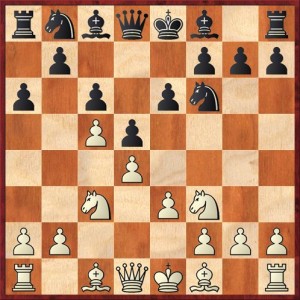
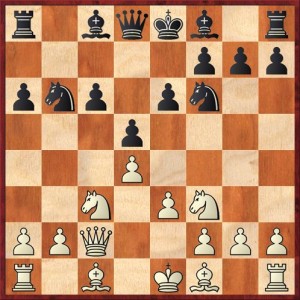
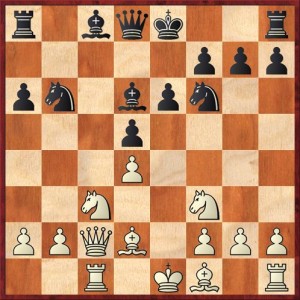
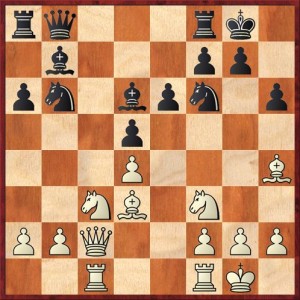
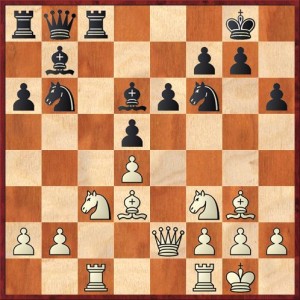
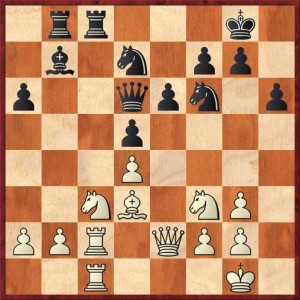
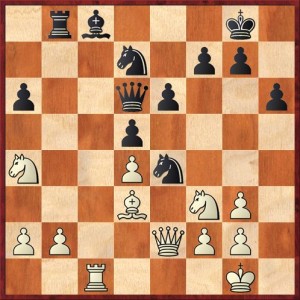
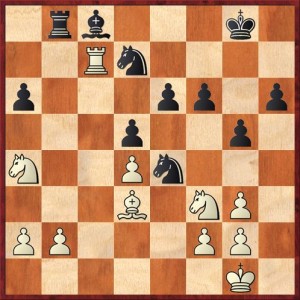
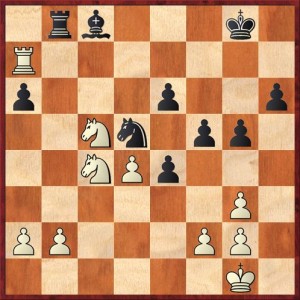
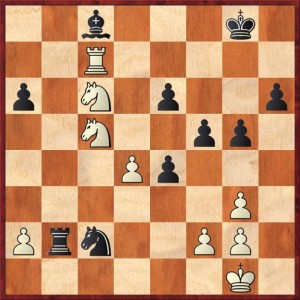
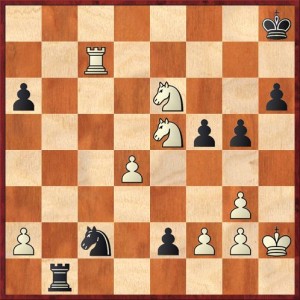



{ 1 comment… read it below or add one }
Invaluable insights from GM Shipov! Such simple explanation of complex plans backed up by solid variations is poetry in itself.
High level play is still mystical for me, the moves are weird. However these analyses open my eyes to the depth and the purpose of the moves, to the minds of the players. Opens up a whole new horizon.
Thank you also for excellent translation, you truly are a master of Russian.